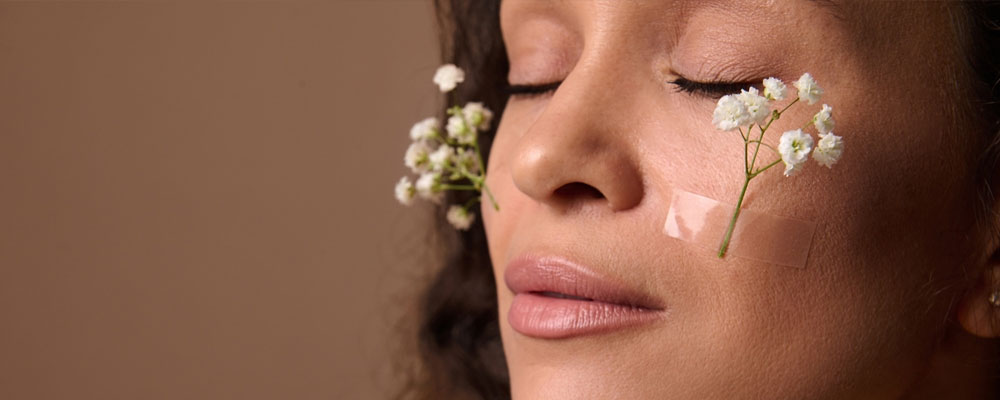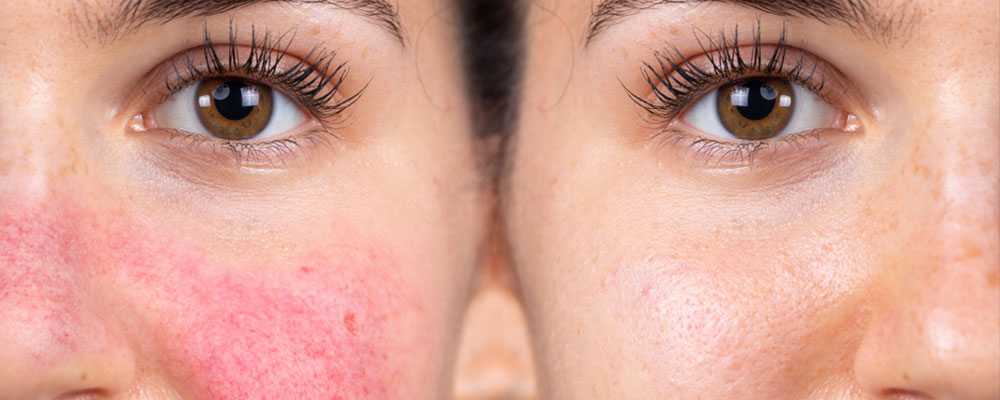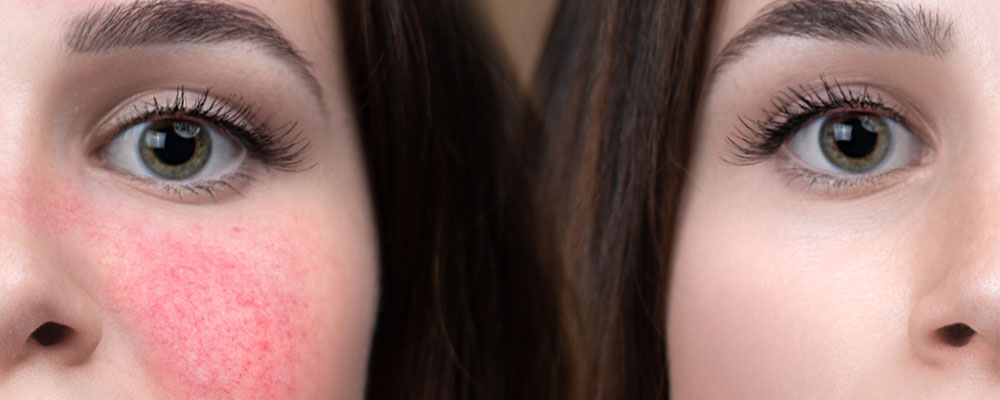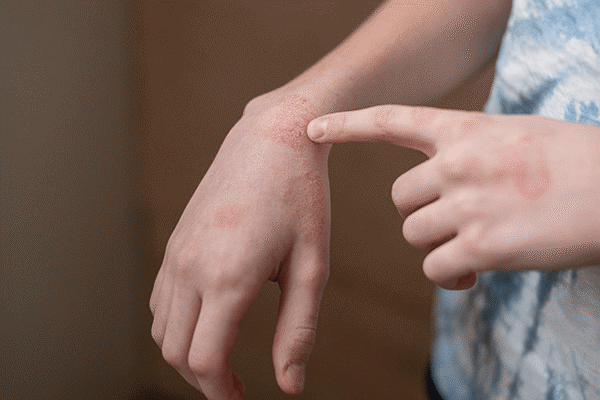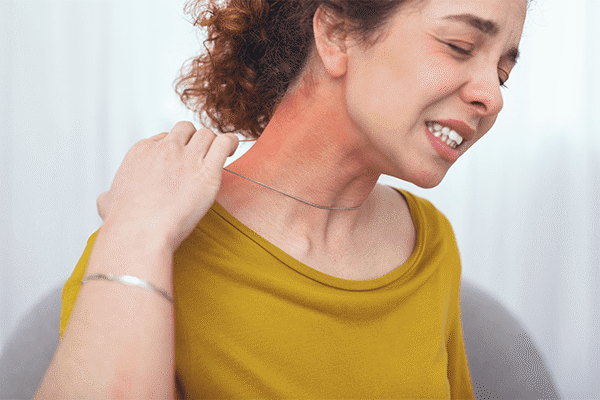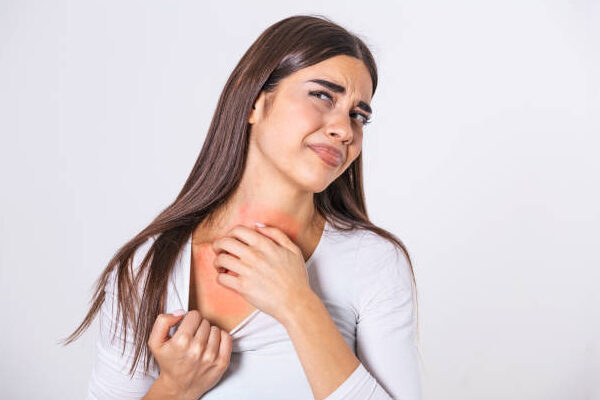Updated on November 6, 2023
Overview:
Do you suffer from facial redness? If this is the case, you may be suffering from a certain skin condition. Both rosacea and lupus can result in a red rash across a person’s cheeks.
Lupus Rash vs Rosacea: Although the etiology of rosacea and lupus is unrelated, many people with lupus are initially misdiagnosed with rosacea. The primary reason for this is that lupus frequently exhibits a visible skin rash with many of the characteristics of a rosacea breakout. Because rosacea affects the face primarily, people who do not have many of the other most common lupus symptoms may begin rosacea treatments until additional symptoms appear.
The similarities between rosacea and lupus usually end with a rash or swelling on the face. So, do you have rosacea, lupus, or something else entirely? To learn more about these conditions, continue reading this blog.
What is Rosacea?
Rosacea is a skin condition. Typically, it manifests itself as a “blushing” pattern across a patient’s cheeks and nose. There are multiple types of rosacea, many with their symptoms differing slightly from one another. Common symptoms include swelling, itching, prominent veins, and redness on the nose with a bulbous or round shape. These symptoms frequently occur in cycles, with certain activities or situations triggering them.
What is Lupus?
Lupus is an autoimmune disease that along with the face can affect a variety of organs. However, many people associate lupus with the characteristic facial rash. The rash is known as a malar rash in lupus. A malar rash appears in the shape of a butterfly across the nose and cheeks. Red patches and sensitivity to sunlight are symptoms of the lupus rash as well as rosacea. There are multiple Lupus Clinical Trials in Michigan being conducted that are investigating its causes and the best possible way to treat its symptoms.
Lupus rash vs Rosacea:
Can a lupus rash be confused with rosacea? It can be if a person is unaware of the subtle differences. The rash, for example, does not have a butterfly configuration in rosacea.
Lupus rash vs rosacea: Aside from the face, the butterfly or malar rash can appear on other parts of the body in the case of lupus. It could appear on the arms, legs, or trunk, for example. It could be the first symptom of lupus. It can be mild, like a mild blush, or severe and scaly. It can last several weeks or months. Dermatologists and rheumatologists believe the cause is an immune system malfunction that causes the body to attack healthy skin tissues.
Rosacea is similar to having a persistent blush or sunburn. Cleansers, cosmetics, and certain moisturizers can aggravate it. The redness is what causes the two conditions to be confused. It is not uncommon for a lupus rash to be misdiagnosed as rosacea or vice versa.
Lupus and rosacea are two distinct conditions, although they can share some overlapping symptoms. Let’s break down some key differences between them:
| Feature | Lupus | Rosacea |
|---|---|---|
| Type | Autoimmune disease (e.g., SLE) | Chronic Inflammatory skin condition |
| Immune System | Attacks healthy tissues | Involves facial blood vessel inflammation |
| Area Affected | Various organs and tissues | Primarily localized to the face |
| Skin symptoms | Butterfly rash, disc-shaped sores, scaly lesions | Facial redness, pus-filled bumps, visible veins |
| Systemic symptoms | Fatigue, fever, potential organ damage | Focus on skin symptoms, systemic symptoms are rare |
| Joint pain | Common, especially in small joints | Rare, typically not associated with joint pain |
| Triggers | Genetic, environmental, and hormonal factors | Triggers include certain foods, alcohol, sunlight |
| Duration of symptoms | Some permanent, some flare-ups Come and go | Symptoms often appear in flares |
| People at higher risk | Females, ages 15- 44, People of color | Females, ages 30-50, White people with fair skin |
Rosacea vs Lupus Prevalence:
Lupus rash vs Rosacea: According to The Lupus Foundation of America, approximately 1.5 million Americans are suffering from lupus. The global figure is estimated to be around five million. While lupus can affect men and women of any age, women account for the vast majority of cases – 90 percent. The majority of lupus patients are between the ages of 15 and 44.
It is thought that rosacea is under-diagnosed, that many people have the skin problem but are unaware of it or have such a mild case that they don’t bother reporting it to their doctors. According to the NRS (National Rosacea Society), 16 million Americans suffer from rosacea, with millions more in temporary remission. Rosacea is a condition that primarily affects people with fair skin. However, people of Asian and African descent have been known to suffer from rosacea.
Lupus rash vs Rosacea Symptoms:
Because some of the symptoms of lupus and rosacea are similar, dermatologists are frequently asked: Is rosacea a sign of lupus? “No,” is the answer. But is it possible to have rosacea and lupus at the same time? Yes, you can have two distinct conditions, but this does not guarantee that this will always be the case. Some people with lupus develop a malar rash but never develop a rosacea rash. Some lupus patients never develop either rash.
Lupus rash vs Rosacea: A comparison of these conditions’ symptoms can help clarify how they differ.
Symptoms of Lupus include:
- A butterfly-shaped rash appears on the bridge of the nose and the cheeks
- Discoid rash, most commonly on the head, arms, chest, or back
- Sunlight sensitivity
- Ulcers in the mouth
- Joint inflammatory disease
- Kidney issues
- Heart or lung issues
- joint discomfort, stiffness, and swelling
- When exposed to cold or stress, the fingers and toes turn white or blue
- Dry eyes
- Headaches, disorientation, and memory loss
Rosacea Symptoms include:
- Easily flush
- Redness that lasts
- The skin remains red and inflamed, and acne-like cysts appear
- Men’s noses become enlarged and bumpy
- The blood vessels on the nose and cheeks swell and resemble spider webs
- Excessive facial skin on the nose
- The eyes are inflamed, watery, and bloodshot
Understanding the signs and symptoms of both lupus rash vs rosacea may assist you in determining whether you have rosacea or lupus.
Rosacea vs Lupus Causes:
Lupus is a complex disease that attacks the body’s cells, tissues, and organs. Nobody knows for sure what causes the autoimmune disease, which can affect organs and skin, but genetics and environmental pollutants are two theories. According to medical data, approximately 40% of lupus patients develop a butterfly rash.
We also know that bloom syndrome, which causes chromosomal abnormalities in the body, can cause rashes such as the butterfly or malar rash. Malar rash is common in people who have Lyme disease, which is caused by ticks. Furthermore, dermatomyositis, a connective tissue disorder, is thought to be one of the root causes of malar rash. A butterfly-patterned rash can occur if you are extremely sensitive to sunlight but otherwise healthy.
Even if you take lupus medication, you may find that certain triggers a flare.
Typical triggers include:
- Stress
- Inadequate sleep
- Infection
- Pregnancy
- Significant surgery (like gallbladder removal or hip replacement surgery)
- Injuries due to trauma (including car accidents)
- Medications such as Sulfa antibiotics (Bactrim), may cause lupus flares in some people (but not all)
- UV rays from the sun and certain types of indoor lighting
- Smoking
Lupus rash vs Rosacea: There is no definitive cause for Rosacea, as there is for lupus, certain factors determine who is more prone to the skin condition. Those with abnormalities in the blood vessels on the face are more likely to develop rosacea, and fair-skinned people develop rosacea at a much higher rate than others.
People with rosacea have an increased number of microscopic mites on their skin. Scientists are unsure whether the mites cause the rosacea or the rosacea causes the mites to overpopulate.
Although they are not thought to be direct causes of the condition, several triggers that may aggravate it has been identified.
These are some examples:
- Hot beverages and spicy foods
- Other alcoholic beverages, such as red wine
- Extreme temperatures
- The sun or the wind
- Emotions
- Exercise
- Blood vessel dilation medications, such as some blood pressure medications
- Some cosmetic, skin, and hair care items
Rosacea vs Lupus Risk Factors:
Rosacea can affect anyone but it is common in people with fair skin. Most people are more likely to develop it if they meet these conditions:
- Being a female
- Having sun-sensitive skin
- Are 30 to 60 years of age
- Are a Smoker
- Having Rosacea in their family history
Lupus on the other hand is also more prevalent in women than men. Other risk factors include:
- Your age: Symptoms and diagnosis most frequently occur between the ages of 15 and 44. Only 15% of people who are later diagnosed with lupus will experience symptoms before the age of 18.
- Your ethnicity/race: Lupus is more common in people of color than in Caucasians in the United States. African Americans, Hispanics/Latinos, Native Hawaiians, Asian Americans, Pacific Islanders, and Native Americans are included. Lupus also appears to develop at a younger age and is more severe in members of these ethnic groups.
- Your family tree: Close kin of people with lupus have a 5-13% chance of developing the disease. However, if their mother has lupus, only about 5% of their children will develop it.
Lupus rash vs Rosacea Complications:
Rosacea complications include the following:
- Rhinophyma is a condition in which the skin of the nose becomes severely reddened, swollen, and pulpy. The enlargement of the sebaceous glands causes this. This complication is more usual in men.
- Conjunctivitis is a condition in which the conjunctiva becomes inflamed (membrane of the eye).
Complications associated with Lupus:
- Scarring on the skin
- Deformities of the joints
- Failure of the kidneys
- Stroke
- The heart attack
- Complications of pregnancy
- Hip devastation (also called avascular necrosis)
- Cataracts
- Fractures of the bones
The leading cause of death in people with lupus is cardiovascular disease, not lupus itself. (It is, in fact, the leading cause of death worldwide.) The number two cause of death for people with lupus is infection.
Rosacea vs Lupus Diagnosis:
Lupus rash vs Rosacea: For many years, doctors relied on blood tests to determine whether a patient had lupus or rosacea. Antinuclear antibodies are looked for in blood tests (ANAs). These are immune-system proteins that attack the center of normal cells. Lupus patients have high levels of ANAs in their blood, so this was a way to distinguish between the two conditions. However, a recent Polish study found that ANA levels were significantly elevated in the blood of more than 50% of rosacea patients. Researchers believe that ANA blood tests should not be used alone to differentiate between lupus and rosacea.
Today, lupus tests may include a complete blood count, kidney and liver evaluation, urine test, ANA test, and erythrocyte sedimentation rate, which measures how quickly red blood cells settle at the bottom of a tube (faster rate indicating systemic disease).
Rosacea is diagnosed primarily through an examination of symptoms and a visual examination of the skin. Proper treatment could include mild, high-quality moisturizers or gels, which are often prescribed. Doctors will also advise rosacea patients to use a broad-spectrum sunscreen with an SPF of 30 all year. If these measures are ineffective, oral antibiotics can be prescribed; however, patients must understand that these medications take time to work. In some cases, it takes months to see significant results.
Both lupus malar rash and rosacea rash are unpleasant, but as many people who have dealt with either condition will tell you, they are manageable if you receive a proper diagnosis, follow treatment guidelines and visit your dermatologist regularly.
Rosacea vs Lupus Treatment:
Treatment options for rosacea vary depending on severity, but may include avoiding known triggers like:
- Sunlight, alcohol, and spicy foods.
- Antibiotics like doxycycline and minocycline It’s unclear how antibiotics help to lessen the severity of the rash. Antibiotics typically take three to four weeks to begin working and six weeks to completely clear rosacea. After a single course of antibiotics, two-thirds of people experience long-term remission. One-third relapse within a few months, necessitating the use of maintenance therapy creams and gels containing antibiotics such as metronidazole that are applied to the skin.
- Diathermy is the application of a small device that generates heat to the damaged blood vessels.
- Laser surgery – to treat enlarged capillaries surgery.
- Surgery – to treat the nose if it has been disfigured by rhinophyma.
To help people manage cutaneous lupus, your provider may advise you to:
- Avoiding exposure to the sun and fluorescent light: Lupus skin lesions are extremely sensitive to both natural and artificial light, so limit your exposure. When you can’t avoid the sun, stay inside during the day and wear a wide-brimmed hat, sun-protective clothing, and sunscreen.
- Injections: Your provider may inject a corticosteroid medication directly into the rash with a needle. Injections of steroids reduce inflammation. These injections may require every few weeks.
- Oral medications: For many years, healthcare providers have used a drug called hydroxychloroquine to treat systemic lupus. It is in charge of your body’s immune response. You may also require other immune-suppressing medications, such as methotrexate.
- Topical medications: Such as creams, lotions, and ointments can help reduce skin inflammation. These need to apply to your skin once or twice a day. Corticosteroid creams and tacrolimus ointment are examples of topical medications.
You should visit your physician near you regularly so that they can monitor your health and adjust your treatment. Because you will need to avoid the sun, your vitamin D levels may fall below normal. Many doctors highly recommend and prescribe Vitamin D supplements.
Bottom-line:
Have you ever wondered if you have lupus rash vs rosacea? Although the rash of lupus and rosacea may appear similar, they are separate conditions that require different treatments.
Physicians have assisted many people in managing lupus and Rosacea with the proper treatments, lifestyle modifications, and routine monitoring. Early detection and treatment of Rosacea can improve prognosis by avoiding scarring, long-term skin problems, and other medical conditions.
To ensure the best possible outcome, avoid sun exposure, schedule regular checkups, and carefully follow your healthcare provider’s instructions. Adhering to a treatment plan and making wise decisions can reduce your risk of lupus and Rosacea flare-ups.

